Lake Glenbawn, on the Hunter River about 12km east of Scone, was built in the early 1950s for irrigation and flood mitigation.
When full, it covers around 2600ha, can hold 750 million litres and has a maximum depth of around 85m in the main basin.
After several lean years when the dam fell to around 30% capacity, for the first time in more than a decade it’s back to consistently high levels. Currently it is around 98% but can go up to 110% of capacity or more, thanks to a redesigned spillway.
In the early 1990s it was stocked with bass, followed by silver and golden perch and then rainbow trout. It has continued to be stocked regularly with bass, goldens and silvers.
A concerted effort by NSW Fisheries and angling clubs over recent years has resulted in it becoming a showcase fishery, especially for bass and goldens – probably the best bass impoundment in NSW.
The dam also has healthy populations of catfish and carp and even the occasional Murray cod.
I have been involved with stocking the dam since the very early 1990s and have fished there since 1991, especially for bass.
The most basic form of fishing in the dam entails the use of bait, either from a boat or around the vast clear shoreline.
For bank fishing you need a rod around 2m, or a handline, and line around 10lb, a No 1 or 1/0 hook and a small sinker.
The best bait varies through the seasons but the better selections include worms, shrimps and freshwater yabbies. Early and late in the day are the most productive times.
Boat anglers can tie up to trees in around 10m of water and lower down baits, especially yabbies and shrimps. When the bait hits the bottom, jig it a couple of times and then lift it up a couple of metres and jig again. Repeat until your bait reaches the surface – quite often the fish can be holding at any depth.
If fishing for silver perch use a smaller sinker and around a No 3 hook with a worm or a shrimp; these fish have small mouths.
Best berley to use around the trees is handfuls of dirt.
Towing lures is an effective way to cover a lot of water in search of bass and goldens. It is also a very relaxing way to enjoy the magnificent scenery and birdlife.
A good sounder helps to locate fish and structure. It can also indicate the depth the fish are holding so you can choose a lure that swims at that level.
Although many people troll bibbed minnow patterns, spinnerbaits, lipless crankbaits, blades and even soft plastics on spinner harnesses are effective at times.
There is a huge and varied range of hardbodies available but you will need to know each lure’s swimming depth, type of action and whether it has rattles or not.
A lure’s swimming depth depends on a lot of factors but the most critical is the line diameter and strength.
This can be a very important tool to make the lure run deeper or shallower.
To make it run shallower, up the line size or go to mono rather than braid, and vice-versa to make a lure run deeper – go to finer braid or a lighter mono.
Lures from some manufacturers can run down to deep as 10m.
Lure action can also be a factor. Bass tend to like a very tight action and strong vibration, while golden perch and cod like a wide sway with a strong, throbbing action.
Spinnerbaits can be also very handy when trolling water down to around 5m and around a lot of submerged structure and snags.
Lipless crankbaits, blades and soft plastics are best used around weed and along shallow banks down to around 4m.
Probably the most popular method is to cast or jig from a boat, although casting from the bank can also be very good with the dam at its present level.
There are so many different types of lures for casting, from surface lures all the way down the water column to deep cranks and jigs.
Lipless crankbaits come in various weights and sizes and can be silent or fitted with internal rattles. Some days the fish home in from a distance on the rattles and other days they can b too noisy, so you should have both.
Spinnerbaits come in various sizes, weights, blade combinations and skirt colours.
Vibrating blades also come in various weights, colours and sizes.
Jigging, be it with soft plastics or ice jigs, is also very productive for deep, schooled fish.
Worked around the banks, soft plastic paddletails, shads or stickbaits around 3” long should be rigged on No 1 to 2/0 jig heads from 1/8oz to 3/8oz, depending on the depth.
On your first visit, deciding where to start fishing such a large impoundment can be very daunting.
Breaking the dam up into several sections can make it a bit easier, especially if you’ve picked up some general hints from other anglers. Few will tell you exactly where they are catching fish but they will usually tell you the general area.
The ‘back of the dam’ I often refer to in my monthly reports runs from the Dogleg, up past the Soil Con Shed, through the 8-knot area, up to the Ruins and thence to where the river runs in.
This section can be very productive in early Spring when it gets good inflow from the snowmelt from the Barrington Tops.
This section contains some excellent areas for trolling, especially along the old riverbed and either side of it. Along both sides of this section there are some very good banks to work. There is good cover in close, especially down the lower end near the Dogleg and up near the rock wall in the 8-knot zone.
The ‘middle section’ is generally referring to the area from Yellow Buoy Bay up past The Narrows to Pelican Point. There is now no island out in the bay.
In the middle section there are very good bays with plenty of cover from Yellow Buoy Bay on the eastern side, right through The Narrows and again out in the main bay.
The Narrows and the heavily timbered areas are very good for bait fishers around the trees in 10m to 12m of water, or simply from the bank.
Along the western side there are also good sections with plenty of cover and very good places for trolling, casting and bait fishing.
Towards Pelican Point and the Dogleg there is not a real lot of cover but the points and bays can be very productive for casting and trolling.
The Main Basin is a very good area for all forms of fishing.
Bait fishing is very effective from the eastern shore and around the timber all along the western and eastern banks.
Boat Harbour is also a very good area for all forms of fishing and it can afford good shelter on windy days.
Trolling is very productive in this lower section, especially from Spring through to the end of Summer. Good areas include the dam wall, the North Run, Cemetery Point, Golden Point, Mayfarm Point and Yellow Buoy Bay.
There are many good areas for casting in the Main Basin, especially the western shore from the dam wall right along to the Drowned Cabins. The entrance to Boat Harbour, Golden Point, Blackboy Hill, May Farm Point and also along the Rock Wall at the top are also very good.
The numerous bays on the eastern bank, especially as you round the point heading north, are also good areas through to Yellow Buoy Bay.
With the dam at its present level there are a lot of areas with submerged timber that only a few years ago were at least 3m out of the water.
A good sounder locates more fish and more fishable structure.
The wide-angle Structure Scan feature on my Lowrance HDS 8 allows me to scope a wide area to locate the sunken timber.
It’s important to find the baitfish on the sounder and note the depth they are holding – this is the level you need to run your lures.
Water temperature is very important, especially in early Spring. Keep an eye on your sounder and look for sunny shallows over Winter and Spring.
Facts
LURE COLOURS
To keep it simple, clearer water means more light and better vision so colour, size, shape and detail appear to make a difference in what lure you should choose.
In dirty water or low light, detail may be less important and dark or fluorescent colours might be more easily seen, presenting a contrasting silhouette.
It is not known what colours fish can actually see but red, purple, orange, yellow, green, blue, silver, white and black some have definitely worked better than others.
When selecting the colour of a hard or soft lure, as you go deeper in the water those colours begin to disappear. At 5m in clear water, all colours can be seen but when you get down to 15m the only colours remaining, are green, blue, silver, white and black.
Here’s a breakdown of some of the time-tested Glenbawn colours.
Red: Especially around October when the firetail gudgeons appear.
Purple: The most outstanding bass and golden perch colour that I have tried. No doubt purple has the enduring colour recognition at distances and also is a hue found in several food species.
Yellow: Tones of yellow have the ability to stand out against most underwater shades. Yellow in particular brilliantly reflects light and contrasts with most everything – cover, sky and the bottom. It might turn to whitish tints at great distances.
Green: The true colour of Summertime nature and the colour of plants. It has never been very popular because it blends in too well with the vegetation.
White, silver, gold: Few living things bear more of these colours than the fishes. White, silver and gold are very effective in muddy water.
Black: Black contrasts against almost any background and is an excellent choice for downrigging or very deep trolling.
Lure choice can vary from week to week, day to day and hour to hour. Some days it may be bibbed lures and lipless crankbaits around the banks, then the fish might go for spinnerbaits around the heavy timber, surface lures in low light, plastics around the weed and especially in the cooler months ice jigs and blades in the deep. Keep in touch through the mags and local knowledge.
Facts
CAUTION: ROUGH WATER!
Glenbawn is a massive body of water. It’s 22.5km from the Eagles Nest at the back of the dam to the ramp near the dam wall. This dam can chop up very quickly and it becomes very rough in the main basin. If caught out in such conditions, use commonsense and head into the sheltered bays until things blow over.
There is limited mobile phone reception out on the dam but there are usually plenty of boats moving around. If you get stuck, it is wiser to seek refuge than attempt the run back.
Facts
TACKLE CHOICES
Tackle required for casting and trolling consists of a medium to fast action 3kg to 4kg rod with a very sensitive tip so as not to impede the action of the lure.
Spin or baitcast outfits are fine. Reels should carry 2kg to 10kg braid or 3kg to 8kg mono and a leader of around 1m to 2m of 5kg to 7kg fluorocarbon.
Facts
BEST TIMES
Glenbawn fishes best from early Spring, when the water hits 17° to 18°, until mid-Summer. Things can then become very slow as the water climbs to around 30° but they pick up again from late Summer to early Autumn. Winter can be OK but the bass and goldens can be quite deep and reluctant to bite.
Facts
YOUR STAY
There is plenty of accommodation available at the dam.
• Lake Glenbawn State Park has cabins and good camping areas on the foreshore, phone 02 6543 7193.
• Lake Glenbawn Holiday Village has three-bedroom houses available, phone 0265437752.
The kiosk near the main boat ramp has all the necessary camping and fuel supplies, plenty of bait and tackle including a good selection of the right lures and great meals. Call Peter and Carol on 02 6543 8355.
• Scone is only 15 minutes’ drive away for all your shopping needs and its pubs and restaurants offer another dining alternative.
• Don’t forget to sample the Hunter Valley wines, especially the full-bodied Shiraz and aged Semillon the region is most famous for!
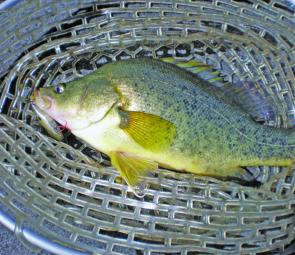
This golden perch fell to a Jackall TN60 in brown dog pattern in around 5m up near the Eagles Nest.
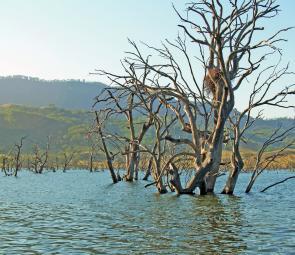
The Eagles Nest, up the very back of the dam, is a very good area for trolling along the old riverbed. You can cast bibbed lures and spinnerbaits among the very thick timber and this is also a very productive area in Summer with surface lures.
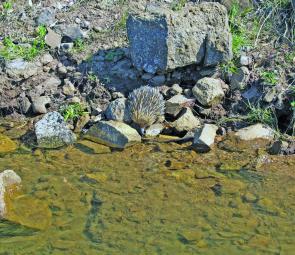
Wildlife abounds in Glenbawn. Seconds after the author took this shot, a 1.8m tiger snake slid down the bank and tried to board his boat!
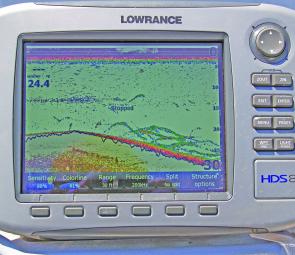
Bass holding along an edge in 10m feeding on the bait suspended 5m above them. This is what the author likes to see on the screen because he knows the fish will be very active.
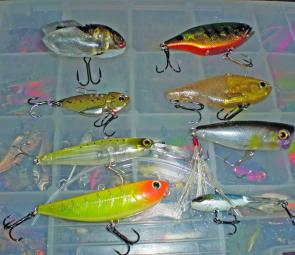
Some of the author’s favourite Glenbawn lures: From left, top, Megabass Siglett, Jackall TN 60; next row, Evergreen 3/8oz blade, Jackall Mask Vib; next row Jackall Squirrel suspending jerkbait, Jackall SK Pop; bottom, Lucky Craft Sammy, Jackall ice jig.
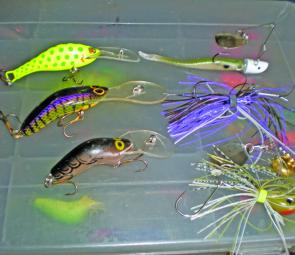
At left, from top, three great Aussie-made trolling minnows that get down around 5m to 6m: Stuckey, Viking Talisman, Halco Poltergeist. At right, bladed lures for fishing the weed and thick timber: from top, Berkley 3” Hollowbelly Split Tail on 1/4oz Nitr
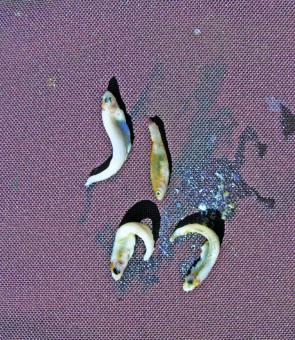
Firetail gudgeons are the major baitfish that Glenbawn’s bass and goldens feed on.
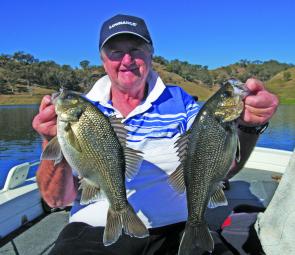
The author with two bass caught in 11m on ice jigs in very early Spring.

Lowrance HDS 8 shot of bass chasing along the edge of a bank. Note bass out to side of boat on Structure Scan image.

These bass were caught on blades in Spring along edge of a rocky drop around the Dogleg.
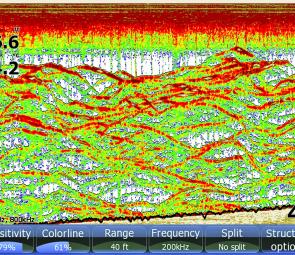
These Winter bass are schooled up along a windblown bank in around 12m.
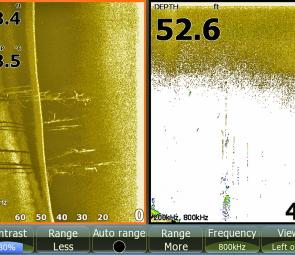
This is the sort of underwater structure where bass gather. With Glenbawn at close to full, you’ll miss it unless you and your sounder are up to the job.

These bass were pulled from around sunken timber on a Bassman Mumbler.
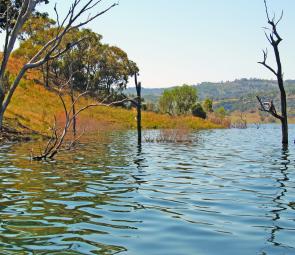
An ideal type of point to target by trolling or casting – there’s plenty of timber and cover out to 14m depths.




